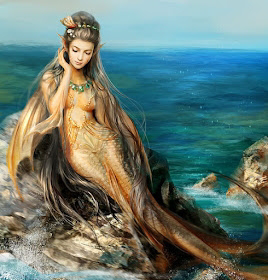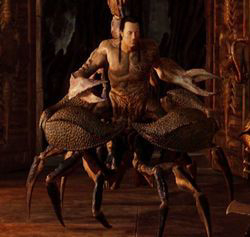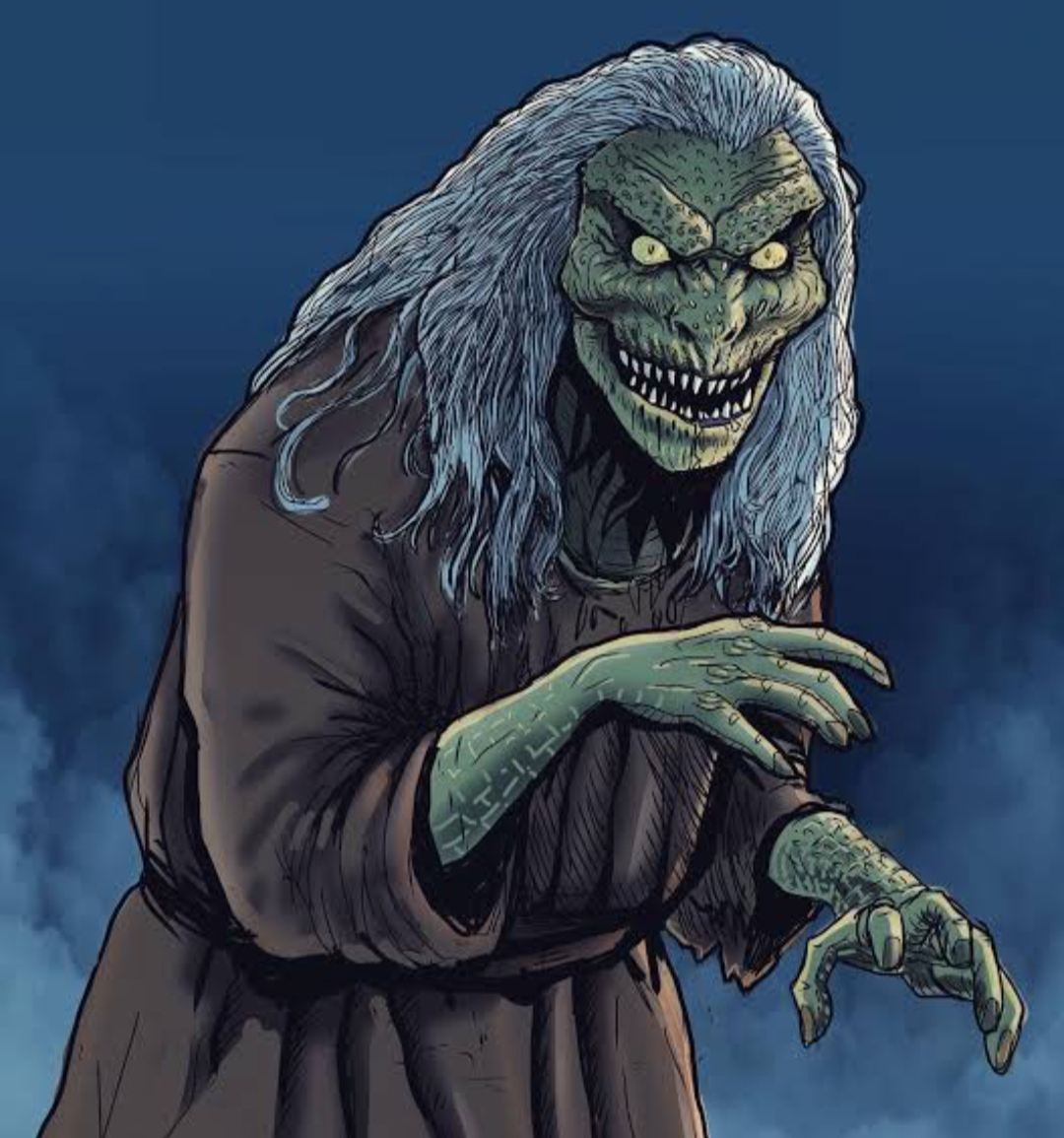Hey! Do you like fantasy like me? does thinking about old centuries, mystic entities,folks and folklores claws your curiosity? Yes! then you're at tha right place. Let me take to for a tour about mythical creatures around the world. who knows! maybe oneday they had ruled the earth with their powers! Lets go!
1. Ceasg
Lets start with a similar one. We all know about mermaids right! But do you know about ceasg? It's a Scottish mythical creature found in sea. It is also known as maighdean na tuinne (maid of the wave) or maighdean mhara (maid of the sea), the ceasg is said to have the upper half of a beautiful woman and the tail of a salmon. The ceasg has the ability to grant three wishes if she is captured. Often she will marry a human man and any sons they have are destined to become fantastic sailors. Eventually, though, the water calls the ceasg back. As a form of mermaid, there are malevolent tales associated with the ceasg. She will sometimes swallow the man whole (or his wife if he is already married), and it takes the destruction of the ceasg’s soul (kept apart in a magical object, often an egg or a marble), to stop her and return the person to safety.
2. Aqrabuamela
Aqrabuamelu, also known as Akhru or Akhruemel, is a mythical creature that originates from ancient Mesopotamian mythology, particularly in Sumerian and Akkadian cultures. It is often described as a scorpion-man or scorpion-human hybrid ( as we have seen in "The mymmy returns" movie as the the 'scorpian king') This creature possesses the upper body of a human and the lower body of a scorpion, combining human intelligence with the formidable strength and venomous sting of a scorpion.
Aqrabuamelu is mentioned in various Mesopotamian texts, including the famous Epic of Gilgamesh, where two scorpion-men guard the entrance to the Cedar Forest. They challenge Gilgamesh and his companion Enkidu when they attempt to enter the forest.
3. Azure dragon
We all know about Chinese dragon. But the Azure Dragon, also known as the Blue Dragon, is one of the Four Symbols of Chinese mythology, which are celestial creatures associated with cardinal directions. The Azure Dragon is specifically linked to the east and is often considered a symbol of spring and renewal. It is depicted as a majestic and powerful dragon with azure or blue scales.
In Chinese mythology and culture, the Azure Dragon is associated with various positive attributes such as vitality, growth, and prosperity. It is believed to protect and bring good fortune to those who revere it. The dragon's association with the east also signifies the rising sun and the beginning of a new day.
The Azure Dragon is an integral part of Chinese cosmology and symbolism, and it is often seen in art, architecture, and cultural celebrations, especially during the Chinese New Year. Alongside the other Three Symbols (the White Tiger, the Vermilion Bird, and the Black Tortoise), the Azure Dragon plays a significant role in representing the balance and harmony of n.ature and the universe in Chinese mythology.
4. Kinnara
The Kinnara, also spelled as "Kinara" or "Kinnari," is a mythical creature from South and Southeast Asian folklore, particularly in Hindu(Indian), Buddhist, and Thai mythology. These beings are often depicted as celestial musicians or half-human, half-bird creatures, typically with the upper body of a human and the lower body or wings of a bird.
Kinnaras are celebrated for their exceptional beauty, melodious voices, and extraordinary artistic talents. They are renowned musicians and dancers, capable of creating enchanting music and graceful dances that captivate those who hear or witness them. In some traditions, Kinnaras are believed to inhabit the Himalayan mountains or celestial realms, living harmoniously with nature.
In Hindu mythology, Kinnaras are associated with the god of love, Kama, and his consort, Rati. They are often portrayed as devotees of Lord Shiva and Parvati, symbolizing the union of human and divine love. In Buddhism, they are sometimes considered symbols of purity and are associated with heavenly realms.
Kinnaras exemplify the themes of beauty, art, and the celestial in South and Southeast Asian cultures, and they continue to be a source of inspiration in various artistic and cultural expressions.
5.Cupacabra
Now mexico. El chupacabra or the chupacabra or chupacabras, literally 'goat-sucker'; from Spanish: (chupa, 'sucks', and cabras, 'goats') is a legendary creature in the folklore of parts of the Americas.being the missing link between myth and reality the chupacabra was first reported in Puerto Rico in 1995, but since then it has been sighted in many other places in the Americas. But stiil as there's no strong poof of them being exist, scientists has declared it as a myth. The Chupacabra is a reptilian or canine-like creature with spines, scales, or fur on its body. It has red or glowing eyes, sharp teeth, and claws. It can stand on two or four legs, and sometimes it has wings or a tail.
The Chupacabra is a bloodthirsty predator that feeds on the blood of animals, especially goats, sheep, chickens, dogs, and cats. It usually attacks at night and leaves behind carcasses with puncture wounds on their necks or chests. Sometimes it also kills humans or abducts children.
Egypt is next. Ah the country full of mysteries and myths. Everyone knows The Sphinx( architecture) is from the Egypt. But do you know the sphinx the mythical creature from ancient Greek mythology. Typically depicted as a creature with the body of a lion and the head of a human, it represents a fusion of human intelligence and animal strength. The Sphinx is renowned for its enigmatic nature, often posing riddles or questions to travelers and devouring those who couldn't answer correctly. Perhaps the most famous tale involving the Sphinx is the Greek myth of Oedipus, who successfully answered the creature's riddle, thereby saving the city of Thebes. The Sphinx symbolizes mystery, wisdom, and the challenges of the human intellect throughout history.
Now let's go to Brazil. Cuca (also known as the Cucuy, Cuco, Cucu, Cucuí or El-Cucuí) is a mythical ghost-like monster, equivalent to the bogeyman, found in Spain and Portugal.While there are a number of Brazilian legends, one of the best known is that of the cuca, a mythical character popularized in Brazilian culture. The cuca, which originally came from the Portuguese coca, a dragon legend, was brought to Brazil in colonial times. The cuca is an ugly old woman who appears in the form of a crocodile and robs disobedient children. The cuca only sleeps once in every seven years, and parents sometimes use this element of the legend to scare children who don’t want to go to sleep, telling them that the cuca will get them if they don’t go to bed. Although cuca came from the Portuguese coca, in Tupi (an indigenous language of Brazil), cuca means to swallow something with a single gulp.
Now this one is really popular in asia. .
kumiho or gumiho or nine tailed fox is a creature that appears in the folktales of east asia and legends of Korea. It is similar to the Chinese huli jing, the Japanese kitsune and the Vietnamese hồ ly tinh. It can freely transform into a beautiful woman or man often set out to seduce men(female ones), and eat their liver or heart.
However, some state that the Gumiho has to wait for a thousand years to turn into a human being. “In other stories, a Gumiho can last 1,000 years without eating or killing anything. However different the details may be, one thing is certain – the creature’s earnest wish and the ultimate goal is to become human.
Now lets turn towards Japan. A kappa is a mythical creature in Japanese folklore that lives in rivers and ponds. It has the body of a child, the skin made of reptile scales, the shell of a turtle, and the hair of a monk. It also has a dish-like depression on its head that holds water, which is the source of its power. A kappa is very cunning and loves to play tricks on humans, sometimes harmless, sometimes harmful. It likes to eat cucumbers and challenge people to sumo wrestling. It can also shapeshift and speak human languages. A kappa can be friendly or hostile, depending on how it is treated by humans kappa —also known as kawatarō, komahiki, with a boss called kawatora or suiko —is a reptiloid kami with similarities to yōkai found in traditional Japanese folklore. Kappa can become harmful when they are not respected as gods.
At last! Africa.The Grootslang or Grote Slang is a legendary creature that is reputed to dwell in a deep cave in the Richtersveld, is a monster freshwater animal recorded in the mythology of the Zulu and Xhosa clans of South Africa, the Grootslang is believed to be among the very first animals created by God. It is an elephant-snake hybrid with lots of intelligence, strength, craftiness and additionally the habit of stealing jewels and valuable items. The name translation of Grootslang is the awesome serpent.
2. ceasg
3. aqrabulamela
5. Azura dragon
6. cuca
7. kinnara
8. sphinx
9. grootslang
10. kappa
11. gumiho
12.chupacabra












Wow😍😍
ReplyDelete